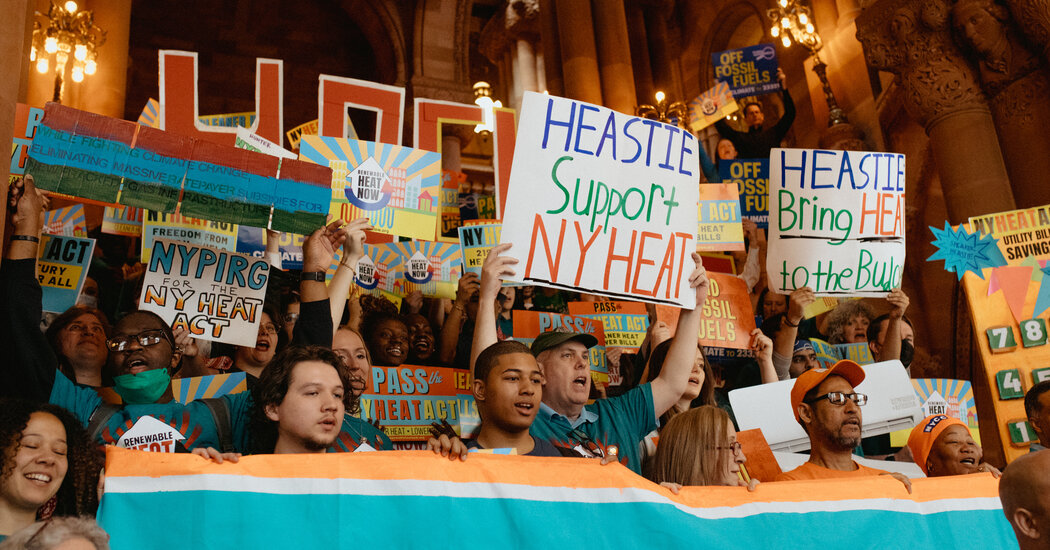[Under current law] gas companies must provide free hookups to new customers within 100 feet of the pipe system. Existing ratepayers subsidize the work.
Getting rid of the so-called 100-foot rule would save ratepayers about $200 million annually and encourage utilities and new customers to explore other energy options.
Beyond what’s in the NYT article, part of the campaign is asking people to call their state legislators and Gov. Hochul. If you’re in New York State, this tool will walk you through connecting to the right offices and leaving a message.
This is the best summary I could come up with:
Efforts to shoehorn the NY HEAT Act into a packed state budget are underway, with supporters contending that swift action is necessary because of the pressures of climate change and opponents say the proposed law should be set aside and more carefully considered.
The bill’s broader aim is to accelerate a shift away from natural gas and help limit emissions from the burning of fossil fuels that cause global warming.
“We are in a race against time,” said Liz Krueger, a Democratic senator sponsoring the bill, “not because of the mandates of our legislation, but because of the reality that the world is in crisis and at risk of self-destruction.”
Those who oppose NY HEAT have raised concerns that the rush to include the bill in the budget could result in future problems with the reliability of energy infrastructure.
One way it will do this is by encouraging entire neighborhoods to shift to renewable energy sources in unison, said Jessica Azulay, executive director of the nonprofit Alliance for a Green Economy.
And the possibility of a cap on energy bills is an enticement for many New Yorkers, said Sonal Jessel, policy director at WE ACT for Environmental Justice, a nonprofit group based in Harlem.
The original article contains 825 words, the summary contains 204 words. Saved 75%. I’m a bot and I’m open source!
So the plan is to charge the new homeowner a hookup fee?
Seems like a bad policy. New York gets cold enough that a heat pump needs a low temp heat source. Heat strips can provide that, but gas does it better.
I think a better angle is to subsidize heat pump and inverter technology. Or tax gas use whenever temps are above 45 degrees. A temperature tax even makes more sense in that you could start it now at like 60 degrees, and schedule the tax to kick in at lower temps each year.
If we want zero emissions, it’s going to mean no fossil fuels. Every new hookup means decades of burning fossil gas.
Not hooking up new buildings is one step along the way; a full retrofit of existing buildings and decommissioning of the gas pipeline network, like Ithaca is already doing, is necessary as well.
Seems like a bad policy. New York gets cold enough that a heat pump needs a low temp heat source. Heat strips can provide that, but gas does it better.
I live in PA, which isn’t that much colder than NY, and I have a heat pump that is rated to keep my house at 70 degrees when it’s zero outside. Then it might need the heat strips, but since they’re powerful enough to do the same thing on their own.
The best use for natural gas at this point is to be burned in turbine power plants to stabilize the grid. That way they’ll power heat pumps which are 3-4x more efficient than burning it in a furnace.
Could the grid handle everyone turning on their heatstrips? that’s a huge change in demand. When mine turn on i see my energy consumption jump from 3kw to 10kw.
Would more natural gas generators need to be built?
Is it more efficient at heating? Converting gas to electricity has losses, and using resistive heat is very inefficient. I don’t think it’s any less efficient than in-home gas heat. gas generation might be regulated better for pollution control though.
Converting gas to electricity has losses, but the 300-400% efficiency of heat pumps more than makes up for it. Also, resistive heat is 100% efficient, while natural gas furnaces are only 90-95% efficient. So even resistive heat would be more efficient.
As for demand, that needs to be solved at a grid level. Though I haven’t had my heat strips turn on all winter.
To be clear, I’m advocating heat pumps with gas only for extreme temperatures until the grid can handle heat strips, while at the same time increasing the cost of using gas over time to apply incentive/pressure to use electric. I don’t think it’s reasonable to ban gas outright, and the amount of political resistance would make it a futile effort.
Another consideration is during an extreme storm that results in power outages, no backup generator will be able to keep up with heat strips. Gas would be fine. I personally have a fireplace and keep wood for emergency use.
Most people - myself included - don’t have a generator or even space for one.
And this isn’t banning gas outright. It’s just increasing the hookup fee. So if you still feel you need gas for whatever reason you can get it, you just gotta pay for it.
Heat strips are really only needed during defrost cycle and so a compressor failure doesn’t freeze the occupant to death in their sleep. Modern cold-climate heat pumps retain their capacity down to 0F
What about sub zero?
Hyper-heating systems can perform at 100 percent of rated capacity in outdoor ambient temperatures as low as 5° F with guaranteed operation down to -13° F. Available in select systems, H2i plus® technology increases the performance to 100 percent at temperatures as low as -5° F.
So your pump doesn’t utilize the heating strips/coils unless the temp hits 0? Pretty darn efficient. You know which model you have?
Many modern inverter drive systems can do it. Mitsubishi HyperHeat and Bryant 38MURA come to mind.
I don’t know the specific model but it’s the base model the sales guy pitched me. No fancy two-stage stuff.
That’s impressive. I had the thought that heat pumps needed the coils below 40° F.
Even many HVAC contractors are under informed here - my guy thought my Carrier heat pump didn’t work under 35 degrees until I showed him the manufacturer documents. Don’t go with a company that uses “rules of thumb” from 1985 when modern sizing and commissioning requires heat load calculations based on your building construction and specific details from the unit spec sheets.
I just replaced this one in December, but even the 15 year old one before that didn’t need the coils until it got well below freezing.
Modern heat pumps can work well down to 15F and cold-climate models continue to work down to 0F
What about sub zero?



